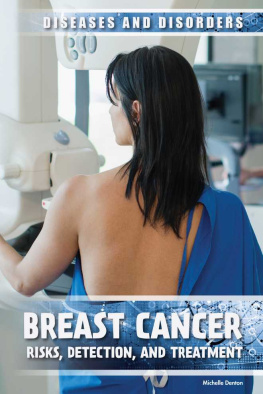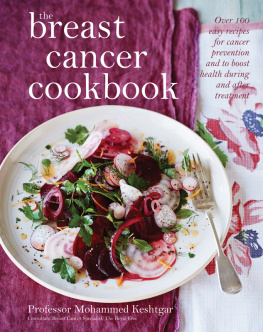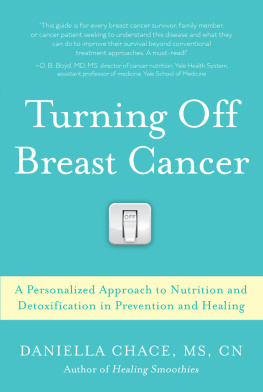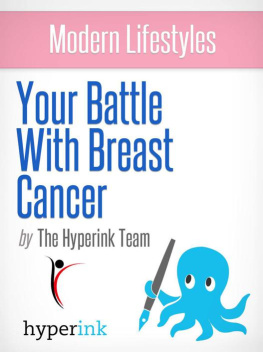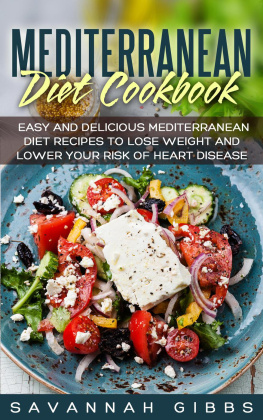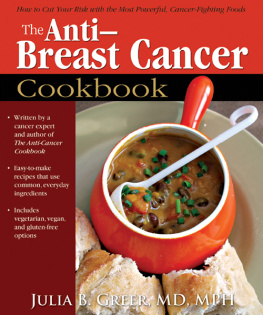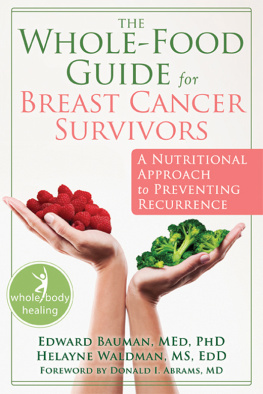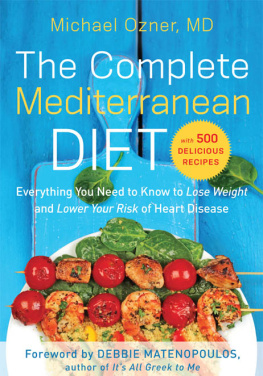Acknowledgments
For funding the study on which this book is based, I want to thank the Susan G. Komen for the Cure Foundation. They encouraged unconventional protocols when the prevailing advice was that low-fat diets were best for health and weight loss.
I am grateful to the women who participated in the study and appreciate their trust in me. They committed to something that was contrary to what they thought, willingly changing their diets, keeping records, and answering my numerous questions. I especially want to thank those who told their stories, an unpleasant task that they agreed to do to help others faced with the same prognosis.
I asked Nancy Verde Barr to write this book with me based on our previous brief work together and her writing. Not completely knowing my nutrition philosophy, she took the material I gave her, researched information, and asked me questions that improved the material enormously. She made my dry, scientific writing readablebringing clarity, logic, and humor to it. Nancy has made this a much more enjoyable book than anything I could have written.
Thanks so much to my father, Robert Flynn, my sister, Martha Flynn Tasca, her husband, Tom, and my nephews, Peter and James, for their help in trying countless recipes. They never complained when trying food experiments, and offered constructive criticism that improved many of the recipes.
Thanks to our editor, Katie McHugh, for considering this project worthwhile, and to our agent, Jane Dystel, of Dystel & Goderich Literary Agency, for bringing it to Katies attention.
Mary
From the moment Mary told me about her work with diet and breast cancer, I was fascinated. When she told me that the success of her diet was due to the high use of olive oil, I was compelled to write about her findings. And so, I am first and foremost grateful to Mary for entrusting her work, her theories, and the stories of her participants to my pen. If there are faults in the interpretations, they are entirely mine, not hers.
Testing recipes can be routineor a heck of a lot of fun. I had a heck of a lot of fun because my cotesters, Tom Mainelli and Noreen Andreoli, made it so. I have worked with Tom off and on since 1990, when as manager of a local Williams Sonoma he hosted a book signing for me at which he served my recipesand prepared them exactly as written (which, woefully, does not always happen). Between various stints in the food, wine, and olive oil businesses, Tom has always come to my assistance when I needed it, and for that I am beyond thankful. Besides providing precise attention to detail, Noreen generously offered her gloriously equipped kitchen for our work, and the space made the testing pure joy, especially because Rex, Noreens affable Cavalier King Charles Spaniel, was constantly in attendance cheering us on. Well, mostly he was encouraging us to drop more food on the floor, but he was always cheerful about our presence in his domain.
I love writing, but when I am in the thick of it, I tend to resemble a deranged hermittethered to the computer days on end, same clothes, no makeup, hair uncombed, ignoring the phone and e-mails. A decidedly unhealthy way of life, which negated the benefits of all the olive oil, vegetables, and whole grains I was consuming. For saving me from the hermit me, my thanks go to Shay Lynch, who taught me the simple secret to his own full, rich, and varied lifebalance. One of the ways he prodded equilibrium into my life was with frequent, exhausting, and stimulating squash lessonsthe game, not the vegetable. Shay had no problem moving me around the court for more than two hours, after which I was energetic and eager to get back to writingand balanced. He is, and always will be, dear to me.
It would be of little use for me to love writing if I didnt have an agent like Jane Dystel. She has always given my book ideas careful attention and valuable suggestions. Shes the best and I thank heras I also thank our editor, Katie McHugh, for believing in this book.
As always, I am grateful to Philip, Brad, and Andrew Barr for everything, but mostly just for being.
Nancy
Bibliography
Barr, Nancy Verde. We Called It Macaroni. New York: Knopf, 1990.
______. Make It Italian. New York: Knopf, 2002.
Herbst, Sharon Tyler. Food Lovers Companion. 3rd Edition. New York: Barrons, 2001.
Krasner, Deborah. The Flavors of Olive Oil: A Tasting Guide and Cookbook. New York: Simon & Schuster, 2002.
Lucas, Geralyn. Why I Wore Lipstick to My Mastectomy. New York: St. Martins Griffin, 2007.
Pollan, Michael. In Defense of Food. New York: Penguin Books, 2009.
Vigilante, K., and M. Flynn. Low-Fat Lies, High-Fat Frauds, and the Healthiest Diet in the World. Washington, DC: LifeLine Press, 1999.
Battling Two Foes
One must not forget that recovery is brought about not by the physician but by the sick man himself. He heals himself, by his own power, exactly as he walks by means of his own power, or eats, or thinks, breathes, or sleeps.
Georg Groddeck, physician and writer, The Book of the It (1923)
Fran was an energetic, super healthy, fifty-seven-year-old working wife and mother of two when she became a statistic. A routine physical exam revealed a lump that proved to be stage II-B breast cancer, linking her life to those of a staggering two and half million women living with this disease. In the words of Dr. Seuss, I have heard there are troubles of more than one kind. Some come from ahead and some come from behind. Dealing with her trouble aheadthe shock, the fear, a difficult course of chemo, surgery, more chemo, and radiationFran did not anticipate the trouble that came from behind. She was rapidly gaining weight.
I wasnt expecting it, but I wasnt distressed by it either. I zoomed all my mental energy into saving my life. I got used to being puffy and round and just kept buying stylish, bigger sizes. When I would get weighed in each week before chemo, I would lament on my gaining, but the nursing staff told me not to worry about my weight. I didnt, but when my treatment was over and my postsurgical pathology was the best I could hope for, I wanted to look as good as I felt. I wanted to get back to my precancer happy, energetic lifestyle, but my body looked worse than ever. Scars on my breast and under my arm were lovely compared to my waist, which was completely gone. My energy was at an all-time low from carrying around the extra pounds.
Time out. Weight gain? How can that be? Arent gaunt and emaciated the common images of a cancer patient? Turns out, not always. According to the American Cancer Society, over half the women undergoing treatment for breast cancer may gain rather than lose weight.
The Health, Eating, Activity, and Lifestyle (HEAL) Study, which began in 1996 to examineamong other factorsthe relationship between weight and breast cancer, looked at the cases of twelve hundred women across the United States. The findings were remarkable, to say the least: From the time of diagnosis through treatment, 74 percent of women battling breast cancer gained body fat and 68 percent gained pounds. The average weight gain was 8.6 pounds, with a range from less than 1 pound to 59 pounds.
Talk about a fightthese women were battling breast cancer and the bulge.
I lost my waist during treatment and havent been able to find it since.
Caroline
If its not one thing, its the hormones. At least thats what most women blame for the uninvited and unwelcome pounds. But the data is inconclusive. The American Cancer Society (ACS) considered a number of possible causes of weight gain: Intense food cravings following the nausea of chemotherapy; slowed metabolism brought on by chemotherapy-induced menopause; decrease in physical activity due to the fatigue that accompanies therapy; and the aforementioned usual suspect, hormone therapy, which is often part of the treatment.


